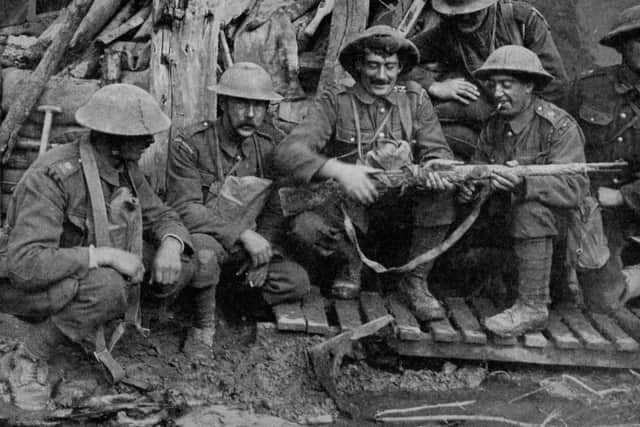The fallen of Larbert '¨and Stenhousemuir


But of course they were not familiar with the phrase ‘1914-18’ and their agony was very far from over. Indeed for the people of our area as well as the rest of the UK, the New Year would bring casualties on a scale not seen previously as the attritional trench warfare continued, culminating in the mud of Passchendaele.
I was reminded of this by Russell MacGillivray’s letter in last week’s Herald appealing for any additional information on the men of Larbert and Stenhousemuir who fought in the Great War. Russell is almost finished a detailed study of local involvement centred on the war memorial at the Dobbie Hall which records the names of the 287 men who died. I have been working with him on the project which will lead to the publication of a book recording everything he has been able to discover about each individual, including their family background and war service with detailed information on the actions in which they were involved and the manner of their deaths. With welcome financial support from the National Lottery’s World War One fund, the book should be available during 2017 and will provide a valuable record for the future.
Advertisement
Hide AdAdvertisement
Hide AdIt will certainly not be a dry list of figures but where the First World War is concerned statistics do have their place. The average age of those who died from Larbert and Stenhousemuir was just over 30 though 80 per cent were under the average. The youngest recruit to die in action was Private Sam Gray, an apprentice moulder at Camelon Iron Works, aged just over 17 when he was killed at Loos in September 1915. The oldest, 45-year-old Lance Corporal Thomas Robb, a barman at Gilmour’s Stenhousemuir pub died in September 1916 in Salonika while serving with the Argylls.


Over 30 different army regiments are represented on the memorial with a third of the casualties suffered by the Argyll and Sutherland Highlanders. Over 30 men died on naval service and many others fell while fighting with the Canadians, Australians and a number of English and Welsh regiments. Most were buried in France, Belgium, Iraq, Palestine, Greece and Turkey, though some died later from wounds or during training at home and were laid to rest in local cemeteries.
They were moulders, patternmakers and gratefitters from the foundries; miners and engineers; clerks, bakers and grocers; doctors, teachers, lawyers and ministers. There were sports stars like Alick Graham who played cricket at the Tryst, Albert Milne who turned out for the Shire and the Warriors, Archibald McLardy, a lawyer with Carron Company who had worn the colours of St Mirren and Queen’s Park and, most famous of all, Gunner Donald McLeod who, after a year with Stenhousemuir, became one of Celtic and Middlesbrough’s greatest ever defenders known as ‘Slasher’ from the ferocity of his tackling! He played for Scotland four times. He died serving with the Royal Field Artillery on October 6, 1917 at Passchendaele.
There are many stories like Donald’s but most of those we remember were ordinary young men leaving their homes to answer the call of duty. If you can help us tell their stories get in touch with Russell on 01324 553586 or myself on 01324 627692.